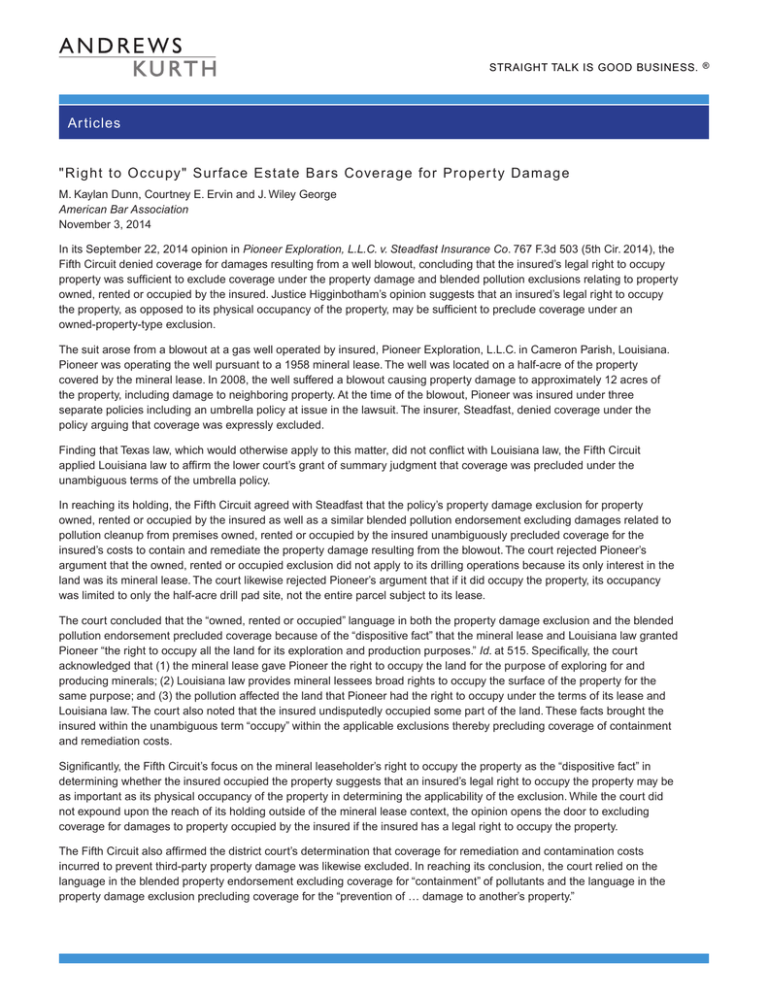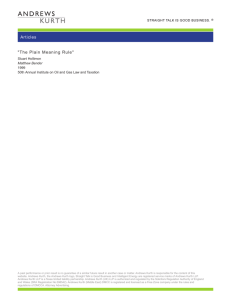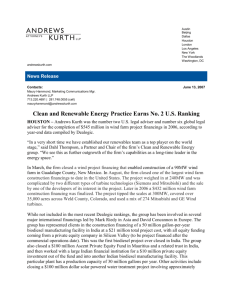
STRAIGHT TALK IS GOOD BUSINESS. ®
Ar ticles
"Right to Occupy" Surface Estate Bars Coverage for Proper ty Damage
M. Kaylan Dunn, Courtney E. Ervin and J. Wiley George
American Bar Association
November 3, 2014
In its September 22, 2014 opinion in Pioneer Exploration, L.L.C. v. Steadfast Insurance Co. 767 F.3d 503 (5th Cir. 2014), the
Fifth Circuit denied coverage for damages resulting from a well blowout, concluding that the insured’s legal right to occupy
property was sufficient to exclude coverage under the property damage and blended pollution exclusions relating to property
owned, rented or occupied by the insured. Justice Higginbotham’s opinion suggests that an insured’s legal right to occupy
the property, as opposed to its physical occupancy of the property, may be sufficient to preclude coverage under an
owned-property-type exclusion.
The suit arose from a blowout at a gas well operated by insured, Pioneer Exploration, L.L.C. in Cameron Parish, Louisiana.
Pioneer was operating the well pursuant to a 1958 mineral lease. The well was located on a half-acre of the property
covered by the mineral lease. In 2008, the well suffered a blowout causing property damage to approximately 12 acres of
the property, including damage to neighboring property. At the time of the blowout, Pioneer was insured under three
separate policies including an umbrella policy at issue in the lawsuit. The insurer, Steadfast, denied coverage under the
policy arguing that coverage was expressly excluded.
Finding that Texas law, which would otherwise apply to this matter, did not conflict with Louisiana law, the Fifth Circuit
applied Louisiana law to affirm the lower court’s grant of summary judgment that coverage was precluded under the
unambiguous terms of the umbrella policy.
In reaching its holding, the Fifth Circuit agreed with Steadfast that the policy’s property damage exclusion for property
owned, rented or occupied by the insured as well as a similar blended pollution endorsement excluding damages related to
pollution cleanup from premises owned, rented or occupied by the insured unambiguously precluded coverage for the
insured’s costs to contain and remediate the property damage resulting from the blowout. The court rejected Pioneer’s
argument that the owned, rented or occupied exclusion did not apply to its drilling operations because its only interest in the
land was its mineral lease. The court likewise rejected Pioneer’s argument that if it did occupy the property, its occupancy
was limited to only the half-acre drill pad site, not the entire parcel subject to its lease.
The court concluded that the “owned, rented or occupied” language in both the property damage exclusion and the blended
pollution endorsement precluded coverage because of the “dispositive fact” that the mineral lease and Louisiana law granted
Pioneer “the right to occupy all the land for its exploration and production purposes.” Id. at 515. Specifically, the court
acknowledged that (1) the mineral lease gave Pioneer the right to occupy the land for the purpose of exploring for and
producing minerals; (2) Louisiana law provides mineral lessees broad rights to occupy the surface of the property for the
same purpose; and (3) the pollution affected the land that Pioneer had the right to occupy under the terms of its lease and
Louisiana law. The court also noted that the insured undisputedly occupied some part of the land. These facts brought the
insured within the unambiguous term “occupy” within the applicable exclusions thereby precluding coverage of containment
and remediation costs.
Significantly, the Fifth Circuit’s focus on the mineral leaseholder’s right to occupy the property as the “dispositive fact” in
determining whether the insured occupied the property suggests that an insured’s legal right to occupy the property may be
as important as its physical occupancy of the property in determining the applicability of the exclusion. While the court did
not expound upon the reach of its holding outside of the mineral lease context, the opinion opens the door to excluding
coverage for damages to property occupied by the insured if the insured has a legal right to occupy the property.
The Fifth Circuit also affirmed the district court’s determination that coverage for remediation and contamination costs
incurred to prevent third-party property damage was likewise excluded. In reaching its conclusion, the court relied on the
language in the blended property endorsement excluding coverage for “containment” of pollutants and the language in the
property damage exclusion precluding coverage for the “prevention of … damage to another’s property.”
STRAIGHT TALK IS GOOD BUSINESS. ®
Ar ticles
The Fifth Circuit further affirmed the district court’s grant of summary judgment on the basis that the oil industry limitation
endorsement’s exclusion for costs relating to “controlling or bringing under control any oil, gas or water well which becomes
out of control” precluded coverage for costs incurred in plugging the well. The court rejected Pioneer’s distinction between
costs relating to controlling a well and plugging a well, concluding that the cost of plugging the well was the final step in
controlling the blowout and thus precluded from coverage.
Copyright © 2014, American Bar Association. All rights reserved. This information or any portion thereof may not be copied
or disseminated in any form or by any means or downloaded or stored in an electronic database or retrieval system without
the express written consent of the American Bar Association. The views expressed in this article are those of the author(s)
and do not necessarily reflect the positions or policies of the American Bar Association, the Section of Litigation, this
committee, or the employer(s) of the author(s).
A past performance or prior result is no guarantee of a similar future result in another case or matter. Andrews Kurth Kenyon LLP is responsible for the content
of this website. Andrews Kurth, the Andrews Kurth logo, Straight Talk is Good Business and Intelligent Energy are registered service marks of Andrews Kurth
Kenyon LLP. Andrews Kurth Kenyon and the Andrews Kurth Kenyon logo are service marks of Andrews Kurth Kenyon LLP. Andrews Kurth Kenyon LLP is a
Texas limited liability partnership. Andrews Kurth (UK) LLP is authorized and regulated by the Solicitors Regulation Authority of England and Wales (SRA
Registration No.598542). Andrews Kurth (Middle East) DMCC is registered and licensed as a Free Zone company under the rules and regulations of DMCCA.



